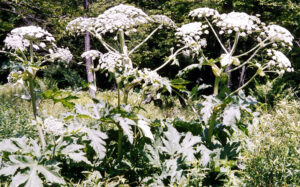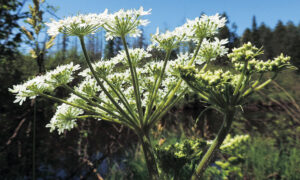Erika Segerson-Mueller, DNR Forest Health invasive plants program specialist, Oshkosh
Erika.SegersonMueller@wisconsin.gov or 715-492-0391

Umbel of a giant hogweed plant. This invasive plant can grow stems 2-4 inches in diameter and can grow as tall as 15 feet. Photo: USDA APHIS PPQ, Oxford, North Carolina; Bugwood.org
This time of year, calls start rolling in about potential sightings of the invasive plant giant hogweed (Heracleum mantegazzianum). Although occurrences of the plant remain rare in Wisconsin, from late May through early July giant hogweed is often confused with a native plant, cow parsnip (Heracleum maximum).
Both are large plants with similar habitat preferences. They prefer shady areas and are often found along stream banks, roadsides and ditches. Giant hogweed is a prohibited species under Wisconsin’s Invasive Species Rule NR40. Its fast growth rate crowds out native vegetation and erodes soil, and skin contact can potentially cause irritation.

Umbel of a cow parsnip plant. This native plant has stems that range from one to two inches in diameter and the plant grows no taller than three to eight feet. Photo: Wisconsin DNR
If you’ve come into contact with giant hogweed, you may be worried about phytophotodermatitis, an adverse reaction caused when sap from the plant gets on your skin and is then exposed to sunlight or moisture.
Just brushing up against giant hogweed or cow parsnip should not cause severe irritation. Simple contact with external parts of the plant, such as leaves or flowers, does not cause skin blistering, burning or scarring. For this harsh reaction to occur, giant hogweed must be broken open and contact made with the sap of the plant.
When you come across a plant that you think might be giant hogweed, check for a few key features to decide if it is the undesirable invasive giant hogweed, or the pollinator-friendly cow parsnip.
- Check the height of the plant. Cow parsnip is generally 3-8 feet high; giant hogweed can reach 8-15 feet tall.
- Look at the flower clusters. While both plants have similar shapes, the flower clusters on cow parsnip will top out at about 18 inches across. Giant hogweed lives up to its name and can have clusters that are 1 to 3 feet across.
- Size up the stems. The stems of cow parsnip will be 1 to 2 inches in diameter and mostly green in color with deep ridges. Giant hogweed stems are 2-4 inches in diameter and will have purple spots or blotches.
Still unsure? Check out this online brochure to compare what you’ve found to each plant’s description.
If you believe you have found giant hogweed, please send photos, the location and a description of the plant to invasive.species@wisconsin.gov.
